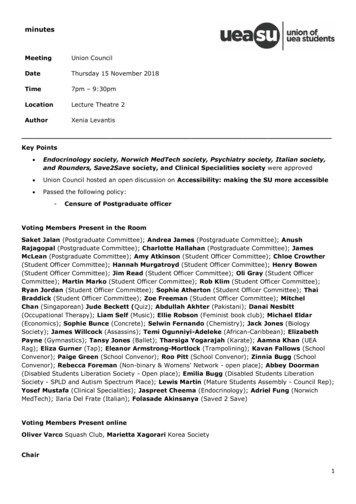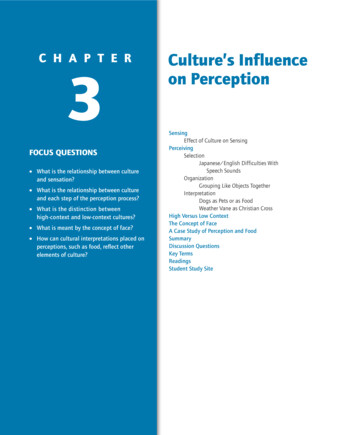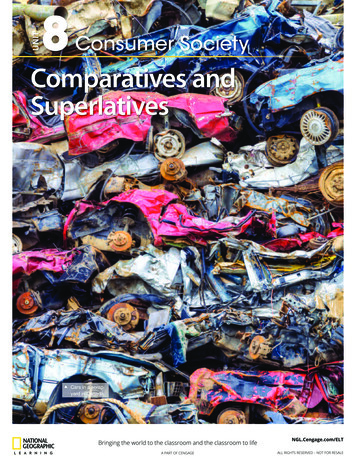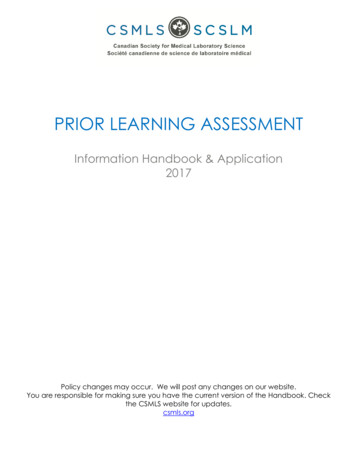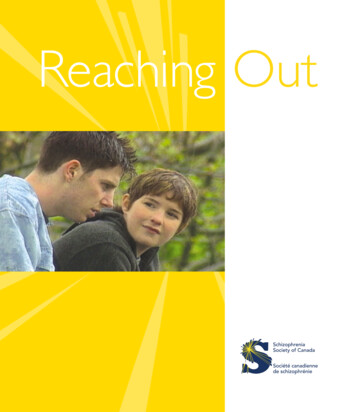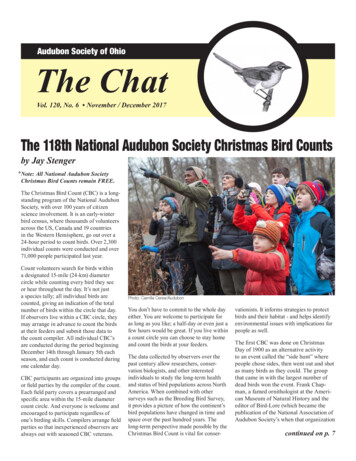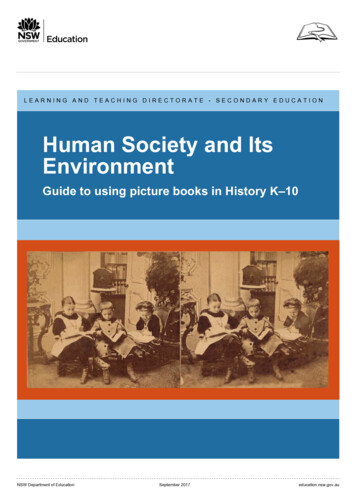
Transcription
LEARNING AND TEACHING DIRECTORATE - SECONDARY EDUCATIONHuman Society and ItsEnvironmentGuide to using picture books in History K–10NSW Department of EducationSeptember 2017education.nsw.gov.au
ContentsAbout this resource3Value of using picture books in history4Tom Tom by Rosemary Sullivan and Dee Huxley6A is for Aunty by Elaine Russell8Grandpa Green by Lane Smith10The Fabulous Friend Machine by Nick Bland12Bittangabee Tribe by Beryl Cruse, Rebecca Kirby, Liddy Stewart and Steven Thomas14Mooncakes by Lorretta Seto and Renne Benoit16What’s Your Story? by Rose Giannone and Bern Emmerichs18Bob the Railway Dog by Corinne Fenton and Andrew McLean20Mustara by Rosanne Hawke and Robert Ingpen22Say Yes: A Story of Friendship, Fairness and a Vote for Hope by Jennifer Castlesand Paul Seden24Mulan: A Story in Chinese and English by Li Jian and Yijin Wert26The Most Magnificent Mosque by Ann Jungman, Shelley Fowles28Jandamarra by Mark Greenwood and Terry Denton30One Minute’s Silence by David Metzenthen, Michael Camilleri32Stolen Girl by Trina Saffioto and Norma MacDonald34The Treasure Box by Margaret Wild and Freya Blackwood36References38Scope and sequence of picture books in History K-1039Cover image: Three children engrossed by books, stereograph photographic print, 1850-1920. Boston PublicLibrary. CC-BY-2.0. When viewed through a stereoscopic viewer, the image is three-dimensional. State of New South Wales (Department of Education), September 2017.The copyright material published in this resource is subject to the Copyright Act 1968 (Cth), and is owned by the NSW Department of Education or, where indicated, by aparty other than the NSW Department of Education (third-party material).Copyright material available in this resource and owned by the NSW Department of Education, is licensed under a Creative Commons Attribution 4.0 International (CC BY4.0) licence. This licence allows you to share and adapt the material for any purpose, even commercially. Attribution should be given to State of New South Wales(Department of Education) 2017.Material in this resource not available under a Creative Commons licence: the NSW Department of Education logo, other logos and trademark-protected material material owned by a third party that has been reproduced with permission. You will need to obtain permission from the third party to reuse its material.This material is also licensed under the National Educational Access Licence for Schools (NEALS). Schools administered or represented by parties to NEALS may freelyreproduce and/or make available online or electronically transmit this material in whole or part for educational use.NSW Department of Education 2017education.nsw.gov.au2
About this resource‘Find yourself a good book one that takes you to places never imagined or shows you things that dazzleyour mind. Find a book that challenges you to think about the world and your place in it. Read a yarn thattweaks your sense of adventure. Find a book that inspires you to discover more.’ – Mark Greenwood,author (undated)This Guide to Using Picture Books in History K–10 aims to: promote and explain the value of using picture books in K-10 history teaching for developing historicalconcepts, skills, knowledge and understandingsencourage K-10 teachers to integrate picture books into their history teaching and programming asstimulus material, a primary or secondary source or as an example of an historical narrativeprovide examples of history teaching and learning activities based around specific core picture booksthoughtfully selected for their historical and literary valueoffer examples of history teaching and learning strategies that enable students to work and think ashistorianssuggest a comprehensive list of stage-related, syllabus-linked picture books as a resource for use inhistory teaching and learninginspire teachers to seek out and share picture books that add enjoyment to, enhance and deepen students’history learning experiences.This project started with a beautiful picture book, opened and shared amongst a group of teachers. And thenanother, and another. As books were held and covers opened, the delightful sensory engagement with picturebooks became evident. With the examination of each book, ways that they were used in teaching and learningwere revealed, magical moments of student engagement were imparted and deeper meanings in theillustrations and words were discussed. This sparked the development of this picture book project that wasfunded by the NSW Department of Education Learning and Leadership Directorate – Secondary Education,HSIE unit. The project includes: Guide to Using Picture Books in Geography K–10, and this document: Guideto Using Picture Books in History K–10.Included in this document are background information, sets of specific teaching and learning activities for atleast one picture book per topic per stage, and a scope and sequence of suggested picture books for historyK-10. Some books are suitable for multiple stages and content, and so it is hoped that teachers will lookbeyond their stage and adapt and modify activities for their students. Most of the books are listed in thePremier’s Reading Challenge Booklist 2017 and are available in school and/or public libraries. Many of theactivities can be applied to other books as well as other primary and secondary sources such as photographs,sketches and paintings.Jackie French, author and historian (undated),states that ‘Good historical fiction wrigglesbetween the cracks of history.’ It is hoped thatteachers and students will enjoy their immersivejourneys ‘wriggling between the cracks’ andmaking memorable discoveries through theintegration of picture books into their historyprograms.Image: Group of children sitting on the grassreading books, 1900-1910. No copyright. StateLibrary of QueenslandNSW Department of Education 2017education.nsw.gov.au3
Value of using picture books in historyWhy use picture books in history teaching and learning‘There is a magic in books that remains unsurpassed by any other medium. Story is one of the most powerfulways we can find out about the world - and the best stories leave us with more questions than answers.’ KathMurdoch, education consultant (2015)Through the ages, illustrations, oral telling, pictorial and written texts have been used to communicate storiesof the past. Just as archaeologists and historians study sources such as rock art, hieroglyphics, illuminatedmanuscripts and illustrated journals, students today can learn about the past through picture books, in additionto other source materials.In history teaching and learning, picture books can: provide a hook for historical inquirybreathe life into historic eventstrigger imaginings of people and their livesconvey varying perspectivesbuild empathy and understanding.Picture books put the people, and their stories, into history. They provide visual representations that canengage students’ imaginations and open their minds to historical inquiry. Students can connect to charactersand ‘walk in their shoes’, building understanding and empathy of past actions and events.How to use picture books in the historical inquiry processPicture books can be used in the historical inquiry process as a: stimulus to engage students and provoke questioning and inquirysource of information: secondary if a retelling, or primary if a personal recountresource for the exploration of historical conceptstool for practising historical inquiry skillsmodel of an historical narrative.Shared and personal readingShare the first reading of a picture book in a comfortable space and enjoy the book in its entirety. Defineculture-specific words and unfamiliar words. Revisit the illustrations and re-read the book with interpretationsand explanations. Having available a class set, or several copies, enables students to actively engage with thebook. If copies of books are not available in your school or local libraries, there may be video readings onYouTube or Vimeo. Single books, or class sets, may be also available for loan through the Department ofEducation’s Henry Parkes Equity Resource Centre.Stimulus for inquiryPicture books can introduce students to the unfamiliar, or to the familiar, in a new light. They can introducenew ideas, challenge understandings and perspectives, and can lead students to want to ‘keep asking anddelving deeper’ (Murdoch, 2015). For instance, whilst The Fabulous Friend Machine by Nick Bland provides acontemporary perspective of mobile phone use, it can raise questions on past communication devices andlaunch an inquiry into the impacts of changing communication technologies.Historical fiction authors often search out the little known stories of the past that spark interest and inquiry. Forinstance, Mustara by Rosanne Hawke and Robert Ingpen, tells the story of the Afghan cameleers’ significantcontribution to exploration and trade in Australia’s inland, whilst introducing Muslim practices to Australia.Secondary source of informationHistorical fiction is a secondary source of information. Groce and Groce (2005) point out that students shouldbe made aware of historical fiction as a genre, which Greenwood (undated) describes as ‘faction’: the blendingNSW Department of Education 2017education.nsw.gov.au4
of historical fact and fiction. Author Jackie French (undated) warns us that historical fiction can ‘mislay thetruth’ and often ‘change history to make a better story’.When using picture books as a source, students can verify facts by locating and comparing secondary andprimary sources. For instance, The Most Magnificent Mosque by Ann Jungman and Shelley Fowles, is a lighthearted account of significant events in the history of Cordoba in Spain. There are inaccuracies in the text thatprovide students with opportunities to contest the story and representations in the illustrations.Students also need to be aware of perspectives that inform authors, for example, Eurocentric viewpoints inbooks relating to the early colonisation of Australia. Students should also be aware of changes in terminologyin reference to Aboriginal and Torres Strait Islander peoples. In their own discussions, writing and role plays,students should use respectful and appropriate terminology rather than now offensive language of the past.Primary source of informationPicture books written as a recount by an author provide a primary source of information, an oral history. Forinstance, A is for Aunty by Elaine Russell, and Remembering Lionsville by Bronwyn Bancroft, recount theauthors’ childhoods: Russell’s on an Aboriginal mission at Murrin Bridge in central NSW, and Bancroft’s in thecountry in northern NSW. In these types of texts, the backstories are also important sources of information.Historical concepts resourceIllustrations in picture books can describe the significance of people or events and provide concrete depictionsof cause and effect. By ‘stepping into’ the illustrations, students can empathise with characters affected byevents. Often written through a child’s perspective, students can make connections to their own lives anddeepen their understandings. For instance, in Memorial by Gary Crew and Shaun Tan, a young boy converseswith his grandfather on the significance of the town’s giant memorial fig tree. On a reading to students in oneStage 2 class, there was an audible gasp at the wordless illustration representing the loss of the tree.Through the interplay of words and images in a picture book, varying perspectives can be portrayed. Forinstance, in One Minute’s Silence by David Metzenthen and Michael Camilleri, the perspectives of both theAustralian and Turkish soldiers who faced each other at Gallipoli are cleverly represented.Historical inquiry skills practiceProviding visual representations of people, places and events, picture book illustrations can be analysed usingstrategies used for analysing photographs and prints. These include See–Think–Wonder or Observe–Reflect–Question (Library of Congress, undated). Using visual literacy strategies, and source analysis skills, criticalanalysis of illustrations enables students to consider the purpose and perspective of the creators as well asextract hidden meaning. For instance, The Treasure Box by Margaret Wild and Freya Blackburn, containsmany layers of information. On close examination, with Google Translate at hand, the torn word collages in theillustrations contain additional information and intertextual references that add depth and meaning.French (undated) states that some historical fiction authors are lazy in their research, relying on secondarysources, rather than going back to the primary sources, which she says should be investigated. Greenwoodagrees, stating that he also immerses himself in the places of his characters. As such, picture books providean opportunity for students to critically analyse, interrogate and contest explanations and interpretations.Historical narrative modelPicture books provide examples of historical narratives that explain and communicate historical information.They are the culmination of research, the drawing out of details, the embodiment of people and themultisensory description of places. An extremely valuable tool for history teaching and learning, picture booksput the ‘story’ into history, communicating historical material in a way that students understand.‘I like to search for the truth, but hope that through my books readers can discover not just the truth, but alsoan understanding of the past’. Mark Greenwood, author (undated)NSW Department of Education 2017education.nsw.gov.au5
Tom Tom by Rosemary Sullivan and Dee HuxleyEarly Stage 1 – Personal and Family HistoriesSynopsisSet in the Top End of Australia in an Aboriginal community, Tom Tom tells the storyof a typical day in the life of a pre-school boy, Tom Tom, and hisinterconnectedness with his family, community and environment. The storyillustrates the structure and security of young Tom Tom’s extended family, therelationships with his relatives, and his activities in a typical day. They includeattending preschool, swimming with friends and spending time with grandparents.Historical concepts and ideasContinuity and change, Perspectives; SignificanceStructure of an Aboriginal family in the Top End and aspects of daily life. Storyabout a family in another place.English conceptsCharacter; Context; NarrativeSelected syllabuscontentFamily structuresThe different structures of families and family groups today, and what they have incommon (ACHHK002). Students: Engaging with thetextidentify and record similarities and differences between families, eg the numberof children in the family, family languages spoken at home, number of adults inthe immediate familycompare and contrast various family groups through photographs and storiesand identify differences between past and presentengage in and respond to stories about families in other places, including thoseof Aboriginal and Torres Strait Islander groupsBuilding the field: Do you know a ‘Tom’? What is his relationship to you?Share the book with the students then re-examine the images, looking for smallerdetails, such as people in the backgrounds. Who are the people in the illustrations?Making connections: Text to text – stories about families. Text to self – Who are thepeople in your family? Text-to-world – local advertisements for family events.Cross curriculumlinksEnglish – Grammar: action verbs, adjectives, compound words. AboriginallanguageGeography – People Live in Places: Important places; Aboriginal and Torres StraitIslander places. Pictorial mapsMathematics – Position: language of position and movementPDHPE – Relationships, getting along with each otherSupporting textsand resource linksGrandpa and Thomas by Pamela Allen (PRC K–2)Grandma, the Baby and Me by Emma Allen and Hannah Sommerville (PRC K–2)Hello from Nowhere by Raewyn Caisle and Karen BlairSame, Same but Different by Jenny Sue Kostecki-ShawGuji Guji by Chih-Yuan ChenSame, But a Little Dif'rent by Kylie DunstanTom Tom: Teacher Notes and supporting website, Lemonade SpringsNSW Department of Education 2017education.nsw.gov.au6
Tom Tom – Learning snapshotsTom Tom’s familyWho are the people in Tom Tom’s family?Reread the first three double pages of Tom Tom. Activate prior knowledge of familyrelationships. Explain ‘mother’, ‘father’, ‘brother-cousins’, ‘sister-cousins’, ‘cousins’,‘aunts’ and ‘uncles’ in Aboriginal kinship systems.List the members of Tom Tom’s family, in groups. How many children in Tom Tom’sfamily? How many adults in Tom Tom’s family?Students draw and label a picture of Tom Tom swimming in Lemonade Springs withhis brothers, sisters, brother-cousins, sister-cousins and other cousins.Image: Children playing in water. Public domainMy familyWho are the people in my family? How is my family similar and different toother people’s families?With assistance from parents or carers, students create a pictorial list, or conceptmap, of the members of their immediate and extended family. They count thenumber of children in their family and the number of adults. With guidance, theyidentify the similarities and differences to Tom Tom’s family.Students draw and label themselves with their family. They compare their pictureswith other student’s pictures and identify similarities and differences.Note: Due to the great diversity in family structures, enable free-drawing rather thanscaffolding of this task. The drawing is each student’s personal viewpoint of ‘family’.Guess who?What do photographs tell us about people’s families ?Students examine the front cover of Tom Tom. How old is Tom Tom in the image?Students bring to school a family photograph of themselves as a toddler and acurrent family photograph. Working with a partner, or in a small story circle,students describe their photographs and the differences between them. Theyidentify each family member and the location of the photograph. Students usehistorical language to identify the differences between the past and the present.Display the photos in a ‘past’ and ‘present’ display. Students play Guess who? totry to identify classmates in their toddler photographs.And then What’s my story for a typical school day?Re-read Tom Tom and jointly create a visual timeline of the events in a typical dayin Tom Tom’s life.In role as Tom Tom, and with the teacher-in-role as the various adults, students‘step into the story’ and use props to enact Tom Tom’s activities throughout his day.Use the illustrations in the picture book to guide the student’s enactments.Standing in a circle, students verbally recall the sequence of activities in Tom Tom’sday. They create a 3D timeline by small groups freezing into Tom Toms’s activities.Students then recount their class’s activities from the previous day. Each studentstates one activity, starting with ‘and then’. Props as memory joggers, or actions,could be added to the recount and explanations.Students create a visual timeline of their previous school day using a six or eightimage storyboard. They use a combination of drawings, photographs, labels and/orverbal explanations that recount their activities and interactions with familymembers.Image: Children riding. Public domainNSW Department of Education 2017education.nsw.gov.au7
A is for Aunty by Elaine RussellStage 1 – Present and Past Family LifeSynopsis‘G is for games. We made marbles from old broken records We also createddolls out of wooden pegs.’Artist and author, Elaine Russell, recounts stories of her childhood growing up onan Aboriginal Mission at Murrin Bridge in central NSW. Elaine uses the alphabet asa scaffold for her memories, each providing different aspects of life with friends andfamily on the mission.Historical concepts and ideasContinuity and change; Perspectives; Empathetic understandingDaily life and family roles of the past, through the eyes of an Aboriginal woman’smemories of her family and growing up on a mission.English conceptsCode and convention; Context; PerspectiveSelected syllabuscontentDaily lives present and pastDifferences and similarities between students' daily lives and life during theirparents' and grandparents' childhoods, including family traditions, leisure time andcommunications (ACHHK030). Students: Engaging with thetextdiscuss similarities and differences from generation to generation, eg familycelebrations and traditions, leisure activities and changes intechnology/communications over time through a range of sourcescompare and contrast daily life with that of parents and grandparents at thesame age through stories or photographs and pose questions to askparents/grandparentsExamine the opened covers of the book before reading the story. Use the seethink-wonder strategy to analyse the place, people and their story on the covers.Read the story, allowing time for observation of the illustrations. Define unfamiliarterms such as ‘mission’ and ‘inspection day’.Making connections: Text to text – texts about places and families, eg Tom Tom byRosemary Sullivan and Dee Huxley. Text to self – own family and family activities.Text to world – places in the local community used by children and families.Cross curriculumlinksEnglish – Grammar: proper nouns, verbs, tense. Punctuation: contractions,exclamation marks.Geography – People and Places: Connections to places. Viewpoints.STEM – Design a toy canoe that floats. Make a billycart.Supporting textsand resource linksTea and Sugar Christmas by Jane Jolly and Robert Ingpen (PRC K–2)Lizzie Nonsense by Jan Ormerod (PRC 3–4)Remembering Lionsville by Bronwyn Bancroft (PRC 3–4)Grandpa's Stories by Rachel Tonkin (PRC 3–4)Grandmother by Jeannie BakerPapa and the Olden Days by Ian Edwards and Rachel TonkinMy First Car was Red by Peter SchossowNSW Department of Education 2017education.nsw.gov.au8
A is for Aunty – Learning snapshotsBillycarts, canoesand games we madeWhat toys and games did children play in the past and the present?‘My Aunty Goldie liked watching us race our billycarts.’Source 1: A is for Aunty by Elaine RussellSource 2: Walker children of Rockmount Station, 1936. No copyright. State Libraryof QueenslandRe-read the following pages in Source 1: A is for Aunty, B is for Billycarts, C is forCanoes and G is for Games. Take time to examine the details in the illustrations.What found objects were used to make the billycarts, canoes, marbles and dolls?Have available some old tin and wooden toys for the students to hold and examine.Source 2Examine Source 2. How has the billycart been made? How do you know? Viewphotographs of children playing with home-made toys by using the search terms‘billy cart’, ‘tin canoe’, and ‘playing marbles’ in Trove – Pictures. How are theysimilar and different to present-day toys? What materials have been used?Students make toys such as canoes from tinfoil pie bases, marbles from clay, anddolls from sticks.In the school grounds, students recreate the illustration in G is for Games and playwith home-made toys and ‘make-do’ games of the past.Lagoon, Nessy, riverand valley – ourspecial placesIn the past, what places were special to children and why?Re-read the following pages in Source 1: L is for Lagoon, N is for Nessy, R is forRiver and V is for Valley. Examine the illustrations. What places were special toauthor Elaine Russell? Why were they special? How do you know?How was the lagoon significant? How did the Aboriginal people describe it?Students create freeze frames of Elaine in her special places. They use a T-chart,to draw or list Elaine’s, and their own, special places and activities. With guidance,they construct a Venn diagram to show similarities and differences.Quandong,suppertime andbush tuckerHow was food prepared and cooked in the past?Reread the following pages in Source 1: Q is for Quandong, S is for Suppertimeand W is for Witchetty Grubs. Observe the details in the illustrations.What information do these pages provide about food and cooking during ElaineRussell’s childhood? Relate this to students’ own experiences of home-made jam,damper, campfire cooking and bush tucker.As a class, make small damper Johnny Cakes and cook them on the school’sbarbeque. Spread with fruit jam and eat them in a yarning circle.T is for teacher andour day at schoolHow was school life in the past similar and different to the present?Reread the following pages in Source 1: M is for Mission and T is for Teacher.Locate the school on the map of the mission. What is the small white building?What did Elaine enjoy most about her school day? What do you enjoy most?Source 3: Free school milk distribution at Newmarket State School Brisbane, 1958.Copyright expired. Queensland State ArchivesSource 4: How Times Change: At School, Education Services AustraliaCollectively view Source 3. What does it tell you school life in the past?Source 3NSW Department of Education 2017Students interact with Source 4 to learn aspects of schooling from the past. Theydraw and label a picture that represents the favourite aspects of their school day.education.nsw.gov.au9
Grandpa Green by Lane SmithStage 1 – The Past in the PresentSynopsis‘ the important stuff, the garden remembers for him.’Grandpa Green is a gardener who likes to shape plants: he’s a topiary specialist!Whenever his young great-grandson visits, he recounts his life. He remembers hislife as a farm boy, a schoolboy with chicken pox, a young man at war and ahusband, father, grandfather and great-grandfather. Grandpa Green is losing hismemory but the topiary plants provide a garden of memories for him.Historical concepts and ideasContinuity and change; Empathetic understanding; SignificanceWhat topiary plants in a personal garden reveal about the past. Why the plants aresignificant to the grandfather who created them.English conceptsCharacter; Connotation, imagery and symbol; IntertextualitySelected syllabuscontentLocal history sitesThe history of a significant person, building, site or part of the natural environmentin the local community and what it reveals about the past (ACHHK044). Students: Engaging with thetextbrainstorm what aspects of the past can be seen in the local areaidentify a significant person, building, site or part of the natural environment inthe local community and discuss what they reveal about the past and why theyare considered importantinvestigate an aspect of local historydevelop a narrative on their chosen aspect of local history which focuses on theremains of the pastMaking connections: Text to text – stories about gardens, eg The Curious Gardenby Peter Brown. Text to self – What gardens do you visit and use? Text to world –school gardens, gardens on the way to school.Share the book with the students. Firstly share just the illustrations and discusswhat the large green salient shape on each page represents. Predict who and whatthe text is about.What is the setting of the story? What is the purpose of the shapes? Who createsthem? Who looks after them? How do you know?Cross curriculumlinksEnglish – Visual literacy: salience, symbolism, reading paths, vectors.Characterisation: Grandson and Grandpa Green. First person voiceGeography – Features of Places: human and natural features, organisation ofplaces, caring for placesScience and Technology – Living World: Needs of living things in theirenvironmentVisual Arts – Ink drawings, colour harmonies, leaf printing, tree portraitsSupporting textsand resource linksThe Curious Garden by Peter BrownKick it to Me by Neridah McMullin and Peter Hudson (PRC K–2)Flotsam by David Wiesner (PRC 3–4)NSW Department of Education 2017education.nsw.gov.au10
Grandpa Green – Learning snapshotsGrandpa Green’smemoriesWhat does each shaped plant in the garden reveal about Grandpa Green’spast?Source 1: Grandpa Green by Lane Smith.Re-read Source 1 to the students. Ponder over the illustrations, looking foradditional details and symbols that add meaning to the memories they represent.Collectively list Grandpa Green’s memories.Examine the intertextual illustrations of the stories Grandpa Green read when hewas sick with chicken pox. Locate and compare images of the stories to the plantshapes. Students imagine they are Grandpa Green in bed with chicken pox. In roleas his parent, tell the story of the Wizard of Oz, accompanied by illustrations. Whichwas Grandpa Green’s favourite character? Why do you think that?Display the double-page foldout at the end of the book. Working in pairs, orrecording onto a device, students verbally retell Grandpa Green’s life, prompted byeach image on the page. Encourage the students to tell it as Grandpa Green.Image: Plant in the shape of an elephant. Public domainOral historyWho can tell us about our local history? What can they tell us?In Source 1, the story is told through the first person voice of the great-grandson. Inrole as Grandpa Green, using first person voice, re-read the first half of the story tothe students. This is an example of an oral history recalling the past.Older members of the community have memories of the past that are a valuablesource of oral history. Invite an elderly long-term member of the community toshare their memories of one or more aspects of the history of the local area.Local history walkWhat aspects of the past can be seen in the local area?Re-visit the illustrations in Source 1. Is there an image that reminds you ofsomething in our local area? What is in our local area that helps people rememberpast events?Take the students for a local history walk through the school grounds, or local area.Look for buildings, plaques, memorials and special plants or gardens that aresignificant to the area’s local history. Take photographs of the sites for display atschool, including any interpretive signage.Back at school, collectively use the area’s local history collection, available throughyour local library’s catalogue, or Trove, to locate early photographs of the sit
NSW Department of Education 2017 education.nsw.gov.au 4 Why use picture books in history teaching and learning ‘There is a magic in books that remains unsurpas
